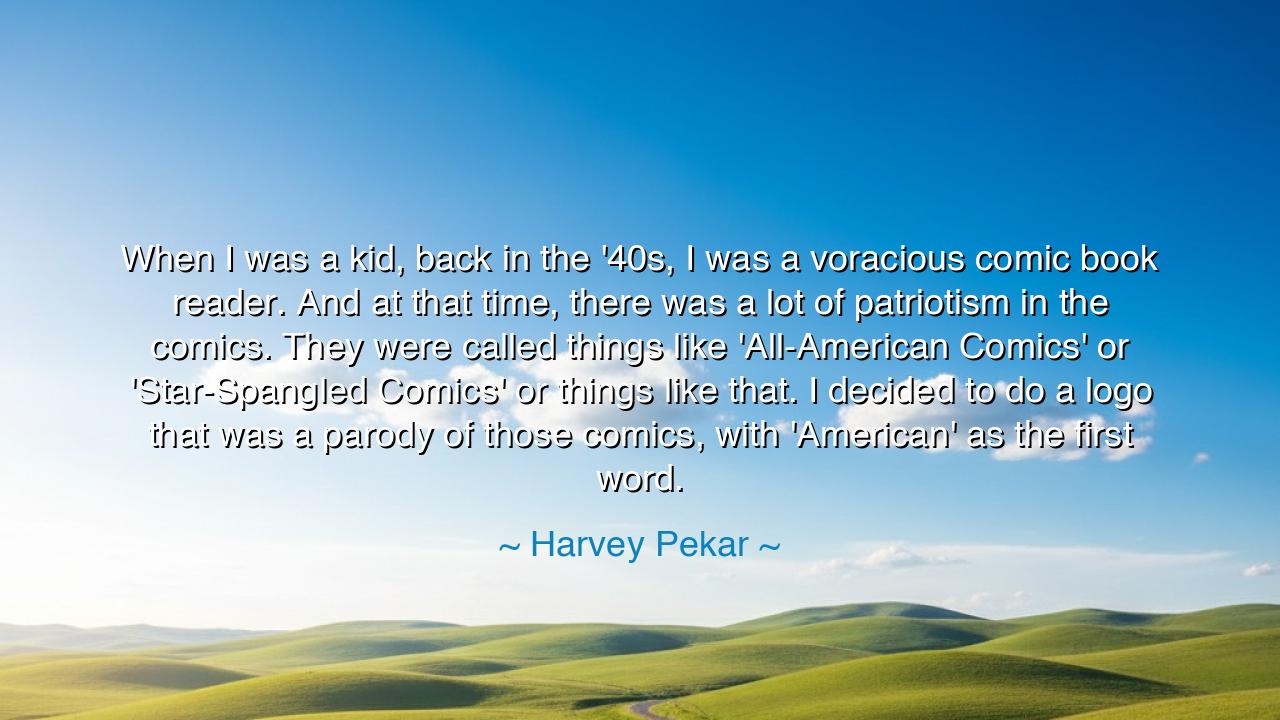
When I was a kid, back in the '40s, I was a voracious comic book
When I was a kid, back in the '40s, I was a voracious comic book reader. And at that time, there was a lot of patriotism in the comics. They were called things like 'All-American Comics' or 'Star-Spangled Comics' or things like that. I decided to do a logo that was a parody of those comics, with 'American' as the first word.






The comic book writer and cultural observer Harvey Pekar once recalled: “When I was a kid, back in the ’40s, I was a voracious comic book reader. And at that time, there was a lot of patriotism in the comics. They were called things like ‘All-American Comics’ or ‘Star-Spangled Comics’ or things like that. I decided to do a logo that was a parody of those comics, with ‘American’ as the first word.” In this reflection, we see not only the memory of a child who grew up in the shadow of war, but also the voice of an artist who sought to wrestle with the power of symbols. Pekar’s words remind us that patriotism, when presented in popular culture, is both a source of inspiration and a tool that can be reshaped, questioned, or even parodied.
In the 1940s, the world was aflame with conflict. The Second World War consumed nations, and America itself leaned on symbols to unite the people. Comic books became more than entertainment—they were vessels of propaganda and pride. Characters like Captain America, who struck blows against tyranny, embodied the spirit of the time. Titles like Star-Spangled Comics and All-American Comics thundered with patriotic fervor, speaking to a generation of children about duty, sacrifice, and national honor. To a young reader like Pekar, these messages were inescapable; they became part of the cultural air he breathed.
Yet, as he grew, Pekar’s vision sharpened. He became a chronicler of ordinary lives, a writer who cared less for heroes in masks than for the daily struggles of clerks, neighbors, and workers. By creating his own logo with “American” at the forefront, but as parody, Pekar held a mirror to those old symbols. He showed that patriotism in art could be questioned, even playfully undermined, while still acknowledging its cultural force. His act of parody was not born of disrespect, but of recognition—that the stories of “real Americans” deserved a place alongside the glossy fictions of spandex and capes.
History gives us many parallels. Consider George Grosz, the German artist who, after World War I, mocked the militarism and nationalism of his age through biting caricature. Like Pekar, Grosz recognized that symbols of patriotism could be both powerful and dangerous. By parodying them, he reclaimed them, forcing people to reflect on what was genuine and what was hollow. Pekar’s parody, too, asked: What does it mean to be “American”? Is it the superhero in a comic, or is it the man waiting for the bus, the woman at the typewriter, the janitor, the teacher, the child in the library?
The deeper meaning of Pekar’s words is that patriotism must never become unquestionable dogma. The comics of his youth had one vision of America: victorious, righteous, shining. His parody suggested another: that America is also flawed, human, ordinary, even weary. To challenge patriotic imagery is not always to reject it; it is to broaden it, to make room for more voices, more stories. True love of country does not erase imperfection, but acknowledges it with honesty.
From this teaching, we learn that symbols are powerful, but they are not sacred in themselves. They are tools—tools that can uplift, but also tools that can obscure. As Pekar demonstrated, to question, parody, or reshape such symbols is itself an act of cultural courage. It asks a people to think, to reexamine, to refuse to be lulled into complacency. In this way, parody becomes not mockery, but a higher form of reflection.
Practically, let each of us learn from Pekar’s example. Do not consume stories, symbols, or patriotic images passively. Ask what they mean, who they serve, and what they leave out. Engage with your culture not as a passive reader but as an active interpreter, ready to add your voice. If you see that the symbols of your time leave ordinary lives unseen, tell those stories. If patriotism is painted only in red, white, and blue triumphs, add the shades of struggle, failure, resilience, and quiet dignity.
Thus, Pekar’s childhood memory becomes more than nostalgia; it becomes a teaching for all generations: patriotism in art must be questioned, reshaped, and expanded. To parody is not to despise, but to keep alive the dialogue of what it truly means to be “American.” For nations are not built only by their heroes—they are built also by their ordinary people, whose stories deserve to be told, honored, and remembered.






AAdministratorAdministrator
Welcome, honored guests. Please leave a comment, we will respond soon